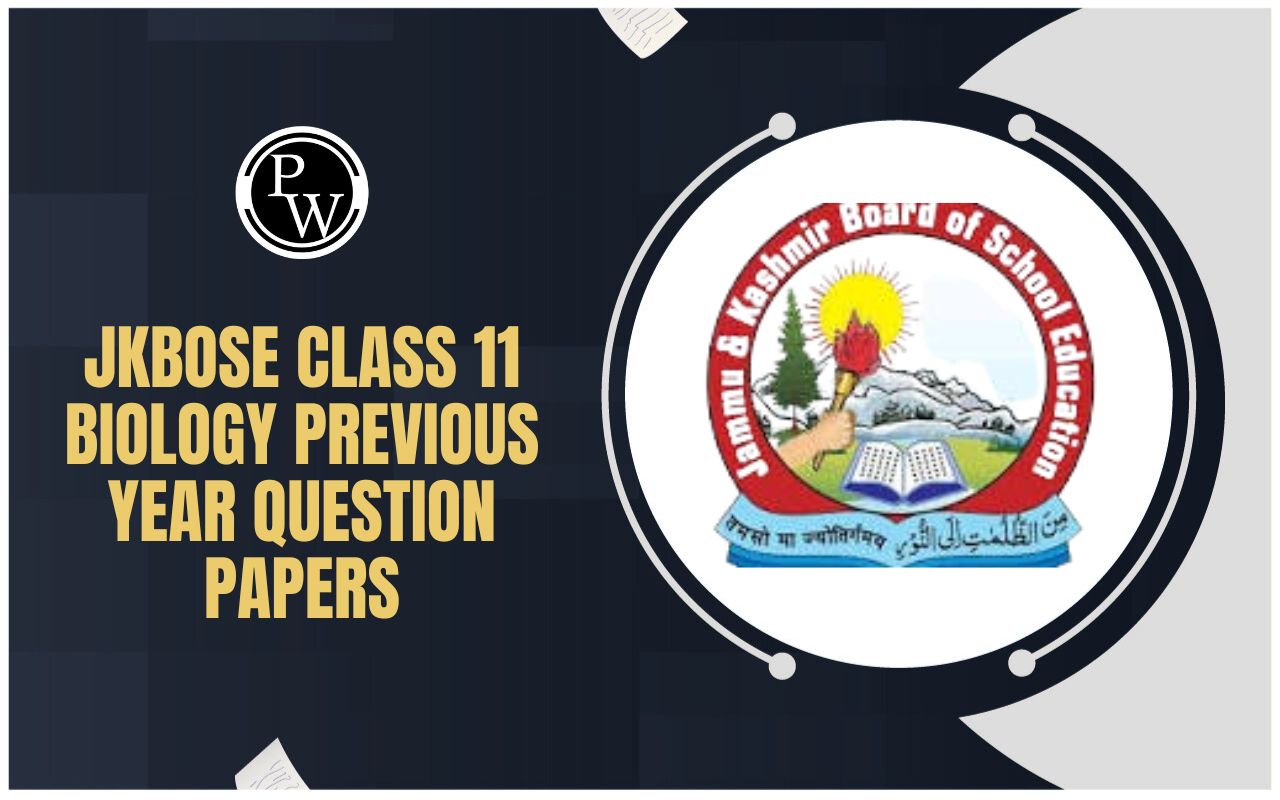
JKBOSE 11th Class Biology Syllabus 2025: For students preparing for the Class 11 exams under the Jammu and Kashmir Board of School Education (JKBOSE), Biology is a compulsory subject for students choosing the science stream.
The Class 11 Biology syllabus introduces students to both Botany and Zoology in a balanced way. From exploring the diversity of life and plant anatomy to understanding how the human body works, the syllabus builds a solid foundation that is essential for board exams and competitive tests like NEET.
The syllabus is important as it focuses on both theory and real-life biological processes. It gives a space to students to observe, analyze, and connect what they study with the world around them.
JKBOSE 11th Class Biology Syllabus 2025 Overview
The JKBOSE 11th Class Biology syllabus 2025 is split into two major sections-Botany (Section A) and Zoology (Section B). Both parts are equally important, contributing a total of 70 marks to the annual assessment.
The syllabus covers fundamental topics like Diversity of Life, Cell Biology, Human Physiology, Plant Growth and Development, and more. Students must refer to the JKBOSE 11th Class Biology Exam Pattern to understand the types of questions to be prepared for the exam.
There are 9 major units: 5 from Botany and 4 from Zoology. The subject includes both theoretical concepts with real-life biological processes which ensures that students not only memorize but understand and apply what they learn.
JKBOSE 11th Class Biology Syllabus 2025 Download PDF
JKBOSE releases the syllabus on its official website. You must have the hard copy of the syllabus to be able to keep a track on your preparation and cover all the important topics. You can highlight key topics, tick off completed topics, and follow your study plan properly. For easy access of the syllabus, PDF of the syllabus has been attached below:
JKBOSE 11th Class Biology Syllabus 2025
Study without using the internet
JKBOSE 11th Class Biology Syllabus 2025 Marking Scheme
The JKBOSE 11th Class Biology Syllabus 2025 Marking Scheme helps students analyze the scoring units and dedicate more time to them, in order to score well. The subject carries 100 marks which are divided into a written exam and a practical assessment.
The written exam is further divided into two sections– Botany (35 marks) and Zoology (35 marks). The practical exam (30 marks) requires students to perform certain experiments, testing their understanding and working of biological processes. Here’s how the marks are distributed between Botany and Zoology.
|
JKBOSE 11th Class Biology Syllabus 2025 Marking Scheme |
||
|
Section A (Botany) |
||
|
Units |
Sub Topics |
Marks |
|
Unit-I Diversity of Life |
Biodiversity: Variety of living organisms; Need and History of classification Artificial, Natural and Phylogenetic classifications. Biosystematics: Taxonomy and Systematics; Concept of species and Taxonomical hierarchy; Binomial nomenclature; Herbarium. Two Kingdom and Five kingdom classifications and their merits and demerits; General characters and classification of Monera, Protista and Fungi; Lichens; Status of Viruses, and Viroids. |
09 |
|
Unit -II Kingdom Plantae |
Classification of plants into major groups; General characters of Algae, Bryophyta, Pteridophyta and Gymnosperms and their classes. Morphology of Flowering plants and their function: Morphology of root, stem and leaf (without their modifications); Morphology of Inflorescence, flower, fruit and seed. Description of family Solanaceae. |
09 |
|
Unit-III Plant Anatomy |
Tissue systems in plants: Epidermal, ground and vascular tissue systems; Anatomy and functions of dicot and monocot root, stem and leaves. |
5 |
|
Unit-IV Plant Physiology |
Respiration: Cellular respiration; Glycolysis, Kreb’s cycle and Electron Transport system (along with ATP energetics); Chemiosmotic hypothesis; Aerobic and Anaerobic respirations; Amphibolic pathways; Respiratory quotient. Photosynthesis: Historical background; Site of Photosynthesis; Photosynthetic pigments; Mechanism of Photosynthesis Light dependent phase (Light reaction), Photosystems; Cyclic and non-cyclic photophosphorylations; Light independent (biosynthetic) phase Calvin (C3) cycle and Hatch & Slack (C4) cycle; Factors affecting photosynthesis; Photorespiration Plant Growth and Development: Characteristics of plant growth; phases of growth, growth rate, growth curve; conditions of growth; differentiation, dedifferentiation and redifferentiation. Sequence of developmental process in a plant cell; Plant growth regulators; Discovery and physiological effects of Auxins, Gibberellins, Cytokinins, Ethylene and Abscissic Acid |
12 |
|
Section B (Zoology) |
||
|
Unit- I Diversity in Living World |
Animal Kingdom; General characters and classification of animals (non-chordates up to phyla level and chordates up to the level of class). National Parks with special reference to Dachigam, Kishtwar, Salim Ali, Kazinag and Hemis. Concept of Sanctuaries and Biosphere reserves. |
8 |
|
Unit-II Structural Organisation & Animal Biomolecules |
Morphology, Anatomy and functions of digestive, circulatory, respiratory, nervous and reproductive systems of Frog. Basic chemical constituents of living bodies; Bio-molecules: Structure and function of Carbohydrates, proteins, lipids and Nucleic acids; Primary and secondary metabolites. Enzymes: Types, Properties and functions |
7 |
|
Unit-III Cell Structure and Function |
Cell: Brief description of cell; Cell theory; Prokaryotic and Eukaryotic cell, Cell wall, Membrane and Cell organelles (Plastids, Mitochondria, E.R., Golgi, Ribosomes, Lysosomes, Nucleus, Vacuoles, centrioles and Cytoskeleton); Cilia and Flagella; Nuclear organisation. Cell Division: Cell Cycle, Mitosis and Meiosis. |
8 |
|
Unit-IV Human Physiology |
Breathing and Respiration: Respiratory system in humans; mechanism of breathing and its regulation in humans; respiratory volume; Exchange of gases and their transport; Respiratory disorders. Body fluids and Circulation: Composition of blood; Blood groups and Rh factor; Lymph; Human Circulatory system; Cardiac cycle and ECG; Double circulation; regulation of cardiac activity; Disorders of circulatory system. |
12 |
|
Total |
70 |
|
The practical exam carries 30 marks and includes sections like observation/ spotting, experiments, and project work from both the sections, Botany and Zoology. Students must refer to the list of experiments mentioned in the syllabus.
JKBOSE 11th Class Biology Syllabus 2025 Benefits
-
The syllabus gives a clear distinction of marks between the sections– Botany and Zoology. As both the sections carry equal marks i.e., 35 marks, it allows students to balance their study time and prioritize both the sections based on their marking scheme.
-
As the JKBOSE follows the NCERT curriculum, it allows students to only prepare for it without wasting time on other books. NCERT is also beneficial for students aiming for NEET, where the majority of questions are based on NCERT only.
-
Chapters like Human Physiology and Plant Systems allow students to relate textbook knowledge to real-life biological functions, making learning more meaningful. This connection with the real-world allows students to develop interest and a good understanding of key concepts and improves retention.
-
The syllabus focuses on both flora and fauna which ensures that students don’t just memorize, but also develop a comprehensive understanding of life processes. It allows students to have a strong conceptual understanding of different topics.
-
Students should also pay close attention to high-weightage units like Plant Physiology and Human Physiology, as these chapters carry more marks and can significantly boost their performance in final exams.
JKBOSE 11th Class Biology Syllabus 2025 FAQs
Is the 11th Biology syllabus of JKBOSE based on NCERT?
Are there practicals included in the Biology syllabus?
Which unit carries the most marks?
How can I get the official JKBOSE Biology syllabus PDF?
Are there any changes in the 2025 syllabus?









